 For my money, Viticulture is the prototypical worker placement game in the board gaming hobby. (With its essential Tuscany expansion, of course.) No other game before or since has so simply laid out the “go somewhere to do something, but you might not have room if others go their first” concept. It remains one of the staples in my gaming library and is still played fairly frequently despite its age.
For my money, Viticulture is the prototypical worker placement game in the board gaming hobby. (With its essential Tuscany expansion, of course.) No other game before or since has so simply laid out the “go somewhere to do something, but you might not have room if others go their first” concept. It remains one of the staples in my gaming library and is still played fairly frequently despite its age.
So when the new expansion arrived at Board Game Quest Headquarters, I was one of the first members of the staff to claim the assignment. (I did have to outduel several other writers to officially earn the job. However, most of them are lightweights, so it wasn’t a big deal.) The new release is called Viticulture World: Cooperative Expansion and, if that wasn’t explicit enough, it converts the standard game into a team-based endeavor where all the players work together to battle an evil wine sorcerer. (I’m pretty sure that’s the theme. I only skimmed the flavor text.)
Viticulture World: Cooperative Expansion is designed by Mihir Shah and Francesco Testini and plays in about 90 minutes for 1-6 winemakers.
Gameplay Overview:
While some of the components contained in Viticulture World can be used in the original game (the Mamas and Papas cards can be shuffled in and even offer some variety in terms of gender designation for the starting couples), the bulk of the components included are only compatible with the new cooperative aspect of the game. For those of you wondering how the original Viticulture plays I won’t be spending a whole lot of time going over those rules (check out Tony’s nearly decade-old review of the original game to find out about that), but you should know that many of the mechanisms present there are carried over into this game.
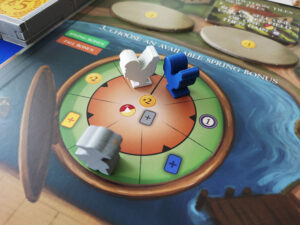
Even though all the players will still be running and operating their own vineyards, what this expansion adds is a shared goal element to the game. Typically, all the team members need to have reached 25 points and collectively reached 10 on the influence track by the end of the game’s sixth year (round) of the game. There are some factors that may change those criteria, but by and large, that is the case. The game maintains its traditional worker placement play and on a player’s turn, they will go out to a spot on the board and trigger the associated action.
Despite the fact that everyone is playing on the same team, locations will get blocked so there does need to be a fair amount of planning among the teammates about who needs to take which action and when. Many of the spots on the board have direct correlations to the original game (planting, harvesting, making wine, etc…) while others are unique to this experience such as the ability to spend money to gain influence and—the game’s most interesting basic concept—paying to upgrade certain locations for later in the game.
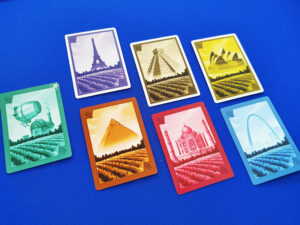
When a player upgrades an action spot it improves the action pretty significantly for later rounds and years. Do you like fulfilling wine orders? How would you like to do that and simultaneously get an extra bonus point? The rulebook and introductory game both make a point to say how important upgrading early and often is to a team’s success and they were not overstating this. Players can also upgrade the action spots themselves to give bonuses simply for performing an action. This also makes locations able to hold any number of players which really opens up the number of options a team has.
The game comes with a scenario deck for each of the seven continents on earth as well as an eighth fictional continent that is a reference to Charterstone and serves as a tutorial. Each of these continents plays pretty differently by introducing new concepts but nothing is ever particularly complex. Without spoiling what these continents do (I’m not sure if this is the type of game where spoilers are to be avoided), one of the easier continents will target specific locations and make them harder to use while still giving players an opportunity to lower the requirements for winning in the end game.
That’s basically how the game works. If all of the team members have successfully achieved the two goals by the end of the sixth year then the team wins. Otherwise, everyone loses.
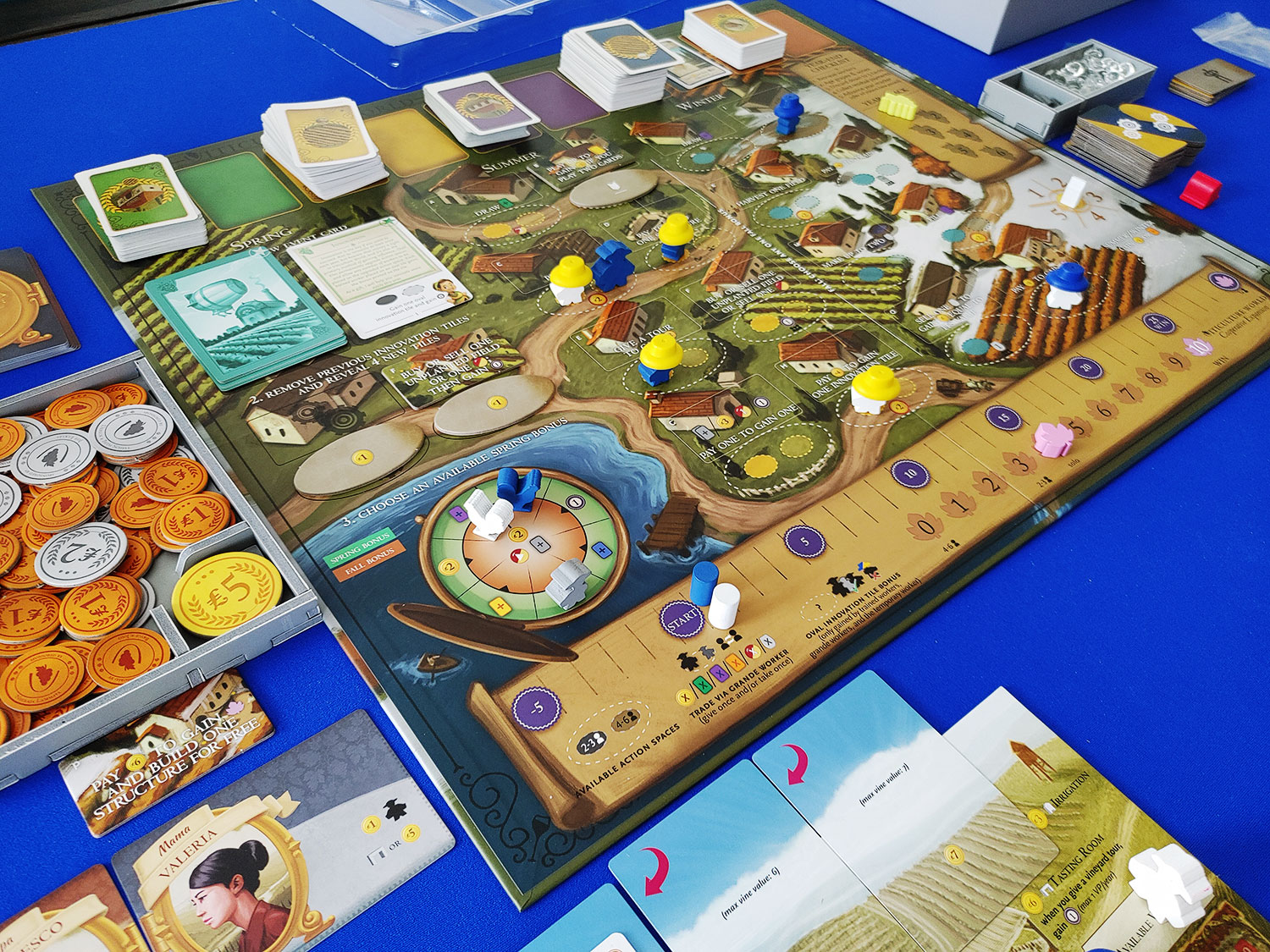
Game Experience:
When Viticulture World showed up at my doorstep I was still of two minds on the concept in general. Viticulture is one of my favorite games and I couldn’t even comprehend how they would successfully convert it into a cooperative experience. And, honestly, the designers have done a pretty remarkable job of distilling (pun intended even though wine isn’t distilled) the original game into a cooperative experience. If you know how to play the original, there are almost no rules overhead aside from understanding a few icons and wrapping your head around the new concept.
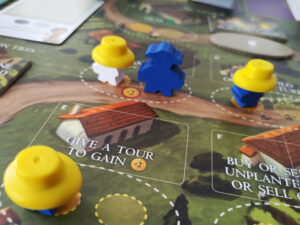
The game uses seasonally restricted workers, which is a fun concept that I actually could see making its way into the base game at some point. (It’s a take on the original’s mechanism where “training” workers get players more to use in later years. Oh… and did I mention that the game comes with hats you can put on your meeples? As my loyal readers know, putting hats on meeples is one of my favorite things on earth and I’ve been obsessed with the idea ever since I played Dwellings of Eldervale. For a full discussion of how the hats in this game compare to the ones in Dwellings, join BGQ’s Discord and @ me.)
The different continents all offer unique challenges and actually feels like you’re traveling to new locations and dealing with their regional complications in regard to making wine. And while not necessary, I always appreciate flavor text on things like this to give me some context for how the mechanism relates to the real-world situation. The game is also pretty challenging for a cooperative game. There might not be Pandemic-level moments when an outbreak causes the entire table to stir but coordinating around the events that pop up and deciding which players should best use what spots are successfully implemented.
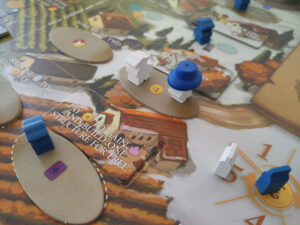
One issue I had with the game is that it’s cooperative but players can still block their teammates as though it’s a competitive worker placement situation. I understand that the designers didn’t want to tamper with the core concept of Viticulture itself, but it is a little strange. (Everyone’s Grande worker mitigates this to a degree since once per year they can go on the same spaces as other people and trade resources with them.) Upgrading spaces obviously negates this blocking conundrum but it’s still present in the game.
Similarly, there is no shared vineyard where players can affect other people’s grapes or wine production. Again, I understand the concept that you are working as something of a winemaking, Avengers-esque collective against the game’s goal. Still, there are times when tracking what all the players on your team have and might need becomes a little clunky since everyone is supposed to be part of a cooperative endeavor. These issues don’t really negatively impact the design, but they are quirks I felt worth mentioning.
Final Thoughts:
Viticulture World is one of those expansions that feels like it came out of nowhere. Was anyone asking for cooperative Viticulture? I can’t imagine so. And yet, it strangely works. If you have a group of people who have played a lot of Viticulture this will almost certainly be a slam dunk at game night. (My wife has gone on the record as saying that this is her preferred way to play Viticulture, but she’s not the game reviewer in the family so take her opinion with a grain of salt.)
Personally, I can’t see this version replacing original-flavor, competitive Viticulture for me but I can definitely see myself breaking this out to play occasionally or even if I’ve just finished a standard game and all the components are already out on the table. Viticulture’s theme has always been one of its main selling points and this game will definitely help players curious about the theme dive into the franchise without having to go at it on their own. My father was so obsessed with the theme that he forced me to teach him the original game and I know he would have loved this as an option instead. Now if only I could get back the two hours of my life it took me to teach him the competitive version…
 Hits:
Hits:
• Easy to play (even if you don’t know the original)
• Great new concepts (upgrading actions is a lot of fun)
• Play variety
• Hats on meeples! Hats on meeples! I repeat: Hats on meeples!
Misses:
• The “separate, but still together” vineyards are a little strange
• Solo mode isn’t as good as the original’s























“Was anyone asking for cooperative Viticulture? I can’t imagine so.” Imagine that there’s a large number of board-gamers who don’t go for overly-competitive games, and would prefer that EVERY game be cooperative, as it suits our personalities better. So on behalf of that large minority, we wish EVERY game had a cooperative mode. In the case of Viticulture, it’s about wine-making, which is inherently a relaxing, chill concept. For me, the real question is why was Viticulture ever competitive?